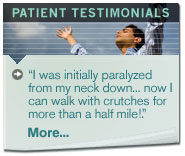
 |
Osteopathic Manipulation Techniques
There are many different types of Osteopathic techniques which are built upon
the osteopathic philosophy of restoration or organic and non-organic movement to
allow the body’s structures to operate with maximum capability and restore lost functions.
Most importantly, freedom from restriction allows the body’s own healing mechanisms
to bring about deep and lasting healing. Below are just a few of the many techniques
within the scope of Osteopathy.
Cranial Osteopathy
Cranial osteopathy is a specific approach within the osteopathic concept. It influences
the structure and cerebral spinal fluid surrounding and bathing the central nervous
system, creating an impact on the total body and initiating the body's inherent capacity
to heal itself. Fascial connections throughout the body are contiguous with the linings
around the central nervous system, including the dura and other structures. Practitioners
of cranial osteopathy utilize a manual approach to accomplish these goals within
the practice of Osteopathic Medicine.
Visceral Osteopathy
Visceral manipulation blends the interrelationship of the structure and function
of the internal organs as a venue to provide treatment of the musculoskeletal system.
Integral organ health and a network of supporting structures may be manipulated to
promote enhanced organic function. Organ mobility may also be enhanced by this procedure
thus as a constituent part of muscular freedom of motion. Manipulation of the viscera
can be beneficially used in the treatment of internal organ dysfunction, structural
musculoskeletal dysfunction, and many other disease states.
Myofascial Release
Your body’s fascial support system has a tensile strength of about 45,000 foot pounds
per square inch which makes it roughly equivalent to that of soft steel. This procedure
is designed to treat primarily the myofascial structures that are ubiquitous throughout
your body. When we consider that your body’s fascial system provides support and
responds to stresses and strains, it is crucial for these to be free of restriction.
In the use of direct myofascial release treatment (MRT) a restrictive barrier is
engaged in the myofascial tissues. The tissue is loaded with a constant force until
release occurs. In treating with indirect MRT the dysfunctional tissues are guided
along the path of least resistance until free movement is achieved so that your body
may operate in a free and smooth manner.
Lymphatic Technique
Lymphatic fluid movement is how your body transports extracellular material such
as waste and nutrients for exchange. This manual procedure is designed to promote
circulation of lymphatic fluids and can be used to treat various illnesses. Many
techniques of this genre involve increasing breath and excursion of the chest wall
and abdomen. The lymphatic system, unlike the arterial system, is a low pressure
system that flows in response to negative intrathoracic pressure within the chest
cavity during the respiratory cycle. Lymphatic stasis or poor movement of lymph leads
to pooling of these fluids and a build up of waste within the body and a lack of
proper distribution of nutrients.
Muscle Energy Technique
Often muscles and joints become restricted to motion due to muscle spasm. In chronic
cases this may lead to fibrosis which is the body’s inappropriate response to a lack
of motion by creating more dense collagen fibers causing fixation of joints. With
this gentle technique, the patient can be directed to use his or her muscles from
a precise position and in a specific direction against counterforce applied by the
physician. Properly applied, Muscle Energy will restore motion, decrease muscle tissue
changes, and modify asymmetry of somatic dysfunction through a normalization of joint
ranges of motion and a break up of fibrous tissues.
Counterstrain
The Counterstrain technique is a a very gentle passive procedure specifically designed
to address severe tender points in ligamentous and muscular tissue. Many severe tender
points are due to mixed up signals coming from unbalanced gamma gain from the Golgi
tendon organs at the site of these soft tissue structures. In this treatment procedure,
the patient is moved passively away from the restricted motion barrier, towards the
position of greatest comfort. At this point appropriate gamma gain distortion within
the affected muscle fibers is restored to normal thus relieving painful stimuli.
Somatoemotional Release
Our bodies provide a map of our life experiences. Physical and emotional traumas
can leave their mark in our fascia. Somatoemotional Release is based on the fact
that the tissues of the body are extremely sophisticated. So sophisticated, that
they are capable of recording significant traumatic events of one's life, burning
these patterns into your muscle memory. Gentle unwinding fascial and cranial techniques
may be utilized to release these imprints that often block healing. Complete health
is attained with the restoration of full motion of our physical body and releasing
of emotional distortions that inhibit the body’s free flow and healing capacity. |
The OHWI Institute
Dr. Sanet believes in the Osteopathic philosophy and treatments which help activate
the body’s own healing mechanisms and guarentees to give 100% of his skill toward
your healing.
Medical Treatments |
Treatments
Osteopathy has provided the pathway toward healing many types of illnesses that have
failed other treatments through restoring blood flow and lymphatic flow and enhancing
respiration through the relaxation of body tissues.
Patient Testimonials |
Courses
OHWI welcomes all licensed practitioners from all countries into its comprehensive
training programs available in North America, Europe, and Asia.
Educational Testimonials |
|
 |
   

|
|

